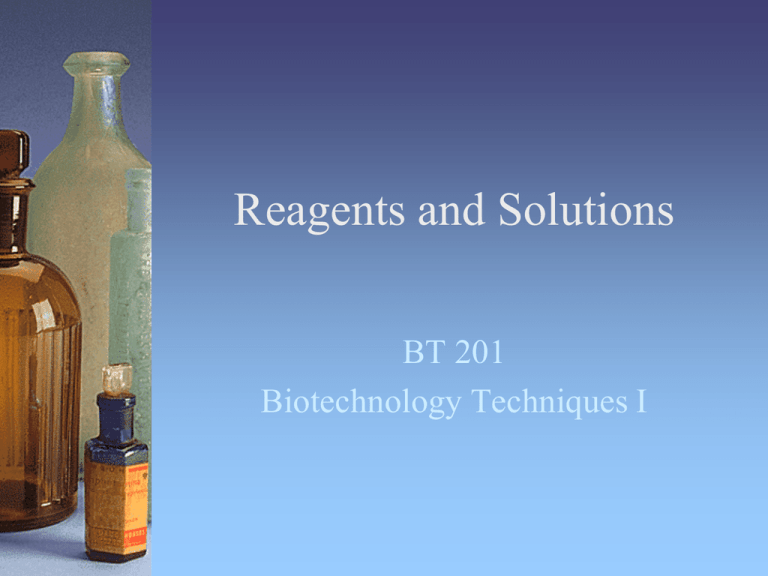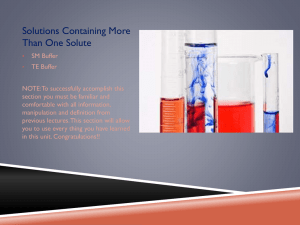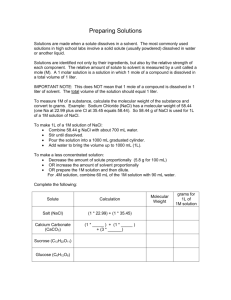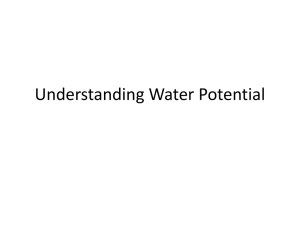CB098-013.026_Reagents and Solutions
advertisement

Reagents and Solutions BT 201 Biotechnology Techniques I Topics to Discuss • Where do solution recipes come from? • Concentration of solute: calculations • Preparing solutions – Making diluted solutions from concentrated stock – Buffers – Bringing solutions to proper pH – Solutions with more than one solute Sources of “Recipes” • • • • Scientific Literature Lab manuals Handbooks Manufacturers and suppliers Terms to Know • SOLUTES -- substances that are dissolved • SOLVENTS -- substance in which solutes are dissolved – Usually water, if not specifically stated otherwise • AMOUNT -- how much • CONCENTRATION -- amount per volume Concentration • The fraction where: – Numerator equals the amount of solute – Denominator usually equals the total volume of entire solution • Solvent + Solute(s) Amount vs. Concentration • Each ribbon represents 2mg of NaCl • What is the amount of NaCl in the tube? • What is the concentration of NaCl in the tube? (in mg/ml) 5 ml Expressing Concentration • WEIGHT PER VOLUME • MOLARITY • PERCENTS a. Weight per Volume % (w/v %) b. Volume per Volume % (v/v %) c. Weight per Weight % (w/w %) Expressing Concentration • PARTS Amounts of solutes are expressed as parts per quantity a. Parts per Million (ppm) b. Parts per Billion (ppb) c. Parts per Thousand (ppt) d. Percents are same category (pph=%) Expressing Concentration • These are not as common in biology • MOLALITY – Moles of solute/kilogram of solvent • NORMALITY – Gram equivalents/liters of solution • For compounds with 1 Hydrogen atom like NaOH and HCl, molarity = normality – This is not true for all solutes Weight Per Volume • A fraction with: Weight of solute (numerator) Total volume (denominator) • So, 10 mg/ml Lysozyme: 10 mg lysozyme in each ml of solution • EX. How much lysozyme is needed to make 100 ml of solution at a concentration of 20mg/ml? Molarity • Number of moles of a solute that are dissolved per liter of total solution. • A 1 M solution contains 1 mole of solute per liter total volume. • A mole is Avogadro’s number of atoms: 6.022X1023 • For compounds, the combined atomic weights of individual atoms are used to express the mole What is a mole? Mole/Weight Relationship Examples Using Helium Moles Helium # Helium Atoms Grams Helium 1/4 1.505 x 1023 1g 1/2 3.01 x 1023 2g 1 6.02 x 1023 4g 2 1.204 x 1024 8g 10 6.02 x 1024 40 g Making a Solution • Find the FW of the solute, usually from label. • Determine the molarity desired. • Determine the volume desired. • Determine how much solute is necessary by using the formula • FW X molarity x volume = g solute needed Making a Solution • Weigh out the amount of solute. • Dissolve the solute in less than the desired final volume of solvent. • Place the solution in a volumetric flask or graduated cylinder. Add solvent until exactly the required volume is reached, “Bring To Volume”, “BTV”. Calculating Solute Needed • How much solute is needed to make 200 ml of 0.5M NaCl? • FW X molarity x volume = g solute needed • (58.44 g/mol) (0.5 mol/L) (0.2 L) = 5.84g Percent Solutions • X % is a fraction numerator is X denominator is 100 • Three variations on this theme • Weight/volume • Weight/weight • Volume/volume Weight/Volume • Grams of solute per 100 ml total solution EX. 20 g of NaCl in 100 ml of total solution = 20% (w/v) solution. • Common in biology, less common in chemistry • EX. How would you prepare 250 ml of a 5% (w/v) solution? Calculating a % (w/v) Solution • How would you prepare 250 ml of a 5% (w/v) solution? • Using proportions: 5%= 5g 100 ml 5 g ? 100 ml = 250 ml Solute needed=12.5 g, BTV 250 ml Calculating a % (w/v) Solution • How would you prepare 250 ml of a 5% (w/v) solution? • By equation: Total volume required is 250 ml. 5% = 0.05 (0.05) (250 ml) = 12.5g of solute required Making the Solution • Weigh out 12.5 g of NaCl. Dissolve it in less than 250 ml of water. • In a graduated cylinder or volumetric flask, bring the solution to 250 ml. Other % Solutions • v/v: • w/w: ml solute 100 ml solution g solute 100 g solution • How would you make 500 g of a 5% solution of NaCl by weight (w/w)? Making the Solution • How would you make 500 g of a 5% solution of NaCl by weight (w/w)? – Percent is 5% w/w, total weight desired 500g. – 5% = 5g/100g – 5g X 500 g = 25 g = NaCl needed 100 g – 500 g – 25 g = 475 g = amount of solvent needed – Dissolve 25 g of NaCl in 475 g of water. Parts • Parts may have any units but have to be the same for all components of the mixture • A solution of 3:2:1 ethylene:chloroform:isoamyl alcohol Parts could be: • 3 liters ethylene • 2 liters chloroform • 1 liter isoamyl alcohol Parts Per ? • Parts per million (ppm): the number of parts of solute per 1 million parts of total solution – 5 ppm chlorine = 5 g of chlorine in 1 million g of solution, – 5 mg chlorine in 1 million mg of solution, – 5 pounds of chlorine in 1 million pounds of solution • Parts per billion (ppb): the number of parts of solute per billion parts of solution. Conversions For any solute: 1 ppm in water = 1 microgram ml • • • Each star represents 1 mg of NaCl. What is the concentration of NaCl in the tube expressed as ppm (parts per million)? What is the total amount of NaCl in beaker? 500 ml 1 ppm in water = 1 μg ml 15 mg/500 ml = 0.03 mg/ml= 30 μg/ml Concentration =30 ppm Preparing a Dilute Solution From Concentrated Stock • Use this equation to decide how much stock solution you will need: C1V1=C2V2 – C1 = concentration of stock solution – C2 = concentration you want your dilute solution to be – V1 = how much stock solution you will need – V2 = how much of the dilute solution you want to make Example Diluted Solution • How would you prepare 500 ml of a 1 M solution of Tris buffer from a 3 M stock of Tris buffer? – – – – The concentrated solution =3 M, C1. The volume of stock needed is unknown, V1 The final concentration required = 1M, C2 The final volume required is 500 ml ,V2 C1 V1 = C2V2 3 M (V1) = 1 M (500 ml) – V1 =166.67ml of stock, BTV 500 ml “X” Solutions • Solution concentration is sometimes written as “X” value • “X” is how many times more diluted the solution is than normal • Working solution is generally diluted to 1X, unless state otherwise Making “X” Solutions • A can of frozen juice is labeled 4X. How would you dilute it to make 1L of drinkable juice? • Using the C1V1=C2V2 equation: C1V1 = C2V2 4X (V1 ) = 1X (1L) V1 = 0.25 L Use 0.25 L of juice, BTV 1L. Buffer Solutions • Laboratory buffers: solutions to help maintain a biological system at proper pH • pKa of a buffer: the pH at which the buffer experiences little change in pH with addition of acids or bases = the pH at which the buffer is most useful Buffers • Some buffers change pH as their temperature and/or concentration changes • Tris buffer is temperature sensitive • Some buffers are sensitive to dilution • Phosphate buffer is sensitive to dilution Adjusting pH of Buffers • To set the buffer to a pH value – Try to get close to its pKa – Most useful for the biological system the buffer is to be used with • Often done using NaOH or HCl – Not the method used for all buffers (see textbook regarding phosphate buffers) Bringing Solution to pH • Adjust pH at the temperature you plan to use the buffer • Mix solutes with most of the solvent volume, but don’t BTV • Stir solution and test initial pH • Add a small amount of acid or base (usually HCl or NaOH, or recipe may specify) • Stir and re-check pH, repeat until pH is correct without overshooting • BTV and re-check pH Multi-Solute Solutions RECIPE I RECIPE II • • • • • • • 1 M MgCl2 • 0.1 M Tris • This recipe gives the final concentration of each solute and is more difficult to follow • Requires calculation of solute needed Na2HPO4 6 g KH2PO4 3 g 0.4% glycerol 10 ml Dissolve in water BTV 1 liter This recipe lists amounts of solutes and is easy to follow Making Multi-Solute Solutions • Example “recipe”: – – – – 0.1 M NaCl 1 mM MgSO4 0.2 M Tris, pH 7.5 0.01% gelatin • Two strategies can be used to make: with stock solutions or without Preparation Without Stock Solutions • Prepare a solution of 0.2 M Tris, pH 7.5 • Decide how much buffer to make • 1 liter of 0.2 M Tris requires 24.2 g of Tris base (MW = 121.1 g/mole) • Dissolve Tris in about 700 ml of water and bring pH to 7.5 • Do not bring Tris to volume Preparation Without Stock Solutions • Calculate grams of each of the other solutes required – 1 liter of 0.1 M NaCl requires 5.84 g of NaCl • Add to Tris buffer – 1 liter of 1 mM MgSO4 requires 1/1000 of its MW • MgSO4 comes in more than one hydrated form • Weigh out correct amount. • Add to Tris buffer Preparation Without Stock Solutions • 0.01% gelatin is 0.1 g in 1 L – Weigh out and add to Tris buffer. – Stir to dissolve • BTV 1 L • Check and record pH Preparation Using Stock Solutions • Solutes are prepared separately as concentrated stock solutions. • Stocks are combined to dilute one another to the needed final concentrations Preparation Using Stock Solutions • Prepare a stock solution of Tris buffer at pH 7.5 a. No set rule as to concentration of stock. b. Make 1 L of 1 M stock by dissolving121.1 g of Tris base in 900 ml of water c. Bring pH to 7.5 d. BTV 1L • Prepare a stock solution of magnesium sulfate a. Make 100 ml of 1M stock by dissolving 0.1 MW of MgSO4 in water b. BTV 100 ml Preparation Using Stock Solutions • Prepare a stock solution of NaCl a. Make 100 ml of 1M stock by dissolving 5.84g in water b. BTV 100 ml • Prepare a stock solution of gelatin a. Make a 1% stock solution by dissolving 1g in water b. BTV 100ml Preparation Using Stock Solutions • To make the final solution, combine the right amounts of each stock. – Use the C1V1 = C2V2 equation four times, once for each solute, since stock solutions are being diluted Preparation Using Stock Solutions • To make 1000 ml buffer, combine: 200 ml 1 ml 100 ml 10 ml Tris stock MgSO4 stock NaCl stock Gelatin stock • BTV 1L • Check and record pH. Solution Making • Either strategy is correct • Making stock solutions is less time consuming than weighing out ingredients every time Disclaimer • This workforce solution was funded by a grant awarded under the President’s Community-Based Job Training Grants as implemented by the U.S. Department of Labor’s Employment and Training Administration. The solution was created by the grantee and does not necessarily reflect the official position of the U.S. Department of Labor. The Department of Labor makes no guarantees, warranties, or assurances of any kind, express or implied, with respect to such information, including any information on linked sites and including, but not limited to, accuracy of the information or its completeness, timeliness, usefulness, adequacy, continued availability, or ownership. This solution is copyrighted by the institution that created it. Internal use by an organization and/or personal use by an individual for non-commercial purposes is permissible. All other uses require the prior authorization of the copyright owner.





